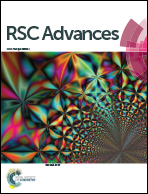Aqueous sol–gel synthesized anatase TiO2 nanoplates with high-rate capabilities for lithium-ion and sodium-ion batteries†
Abstract
Anatase nanoplates were successfully synthesized by a sol–gel method and exhibit superior electrochemical performance in LIBs and SIBs. Nanoplates with 10 nm particle sizes were produced by thermally decomposed titanium–terephthalate hybrid materials. In LIBs, the anatase nanoplates deliver a 100 mA h g−1 capacity at 10C, maintaining 150 mA h g−1 capacity at 5C for 500 cycles. Anatase with high crystallinity exhibits fairly good rate capability in SIBs, delivering 53 mA h g−1 capacity at 30C. Using ex situ X-ray diffractometry and X-ray photoelectron spectroscopy, anatase was discovered to trap Na, forming metallic Ti0 and amorphous sodium titanate in the chemical states of Ti3+ and Ti2+. The sodium titanate is structurally stable and electrochemically reversible with the redox couple of Ti4+/Ti3+. It is suggested that pseudocapacitance comprises most of the capacity in the first cycle. After the activation, anatase gradually stores more capacity by insertion. Therefore, it is demonstrated that anatase nanoplates with this promising insertive/extractive host structure are promising anode materials for LIBs and SIBs.


 Please wait while we load your content...
Please wait while we load your content...